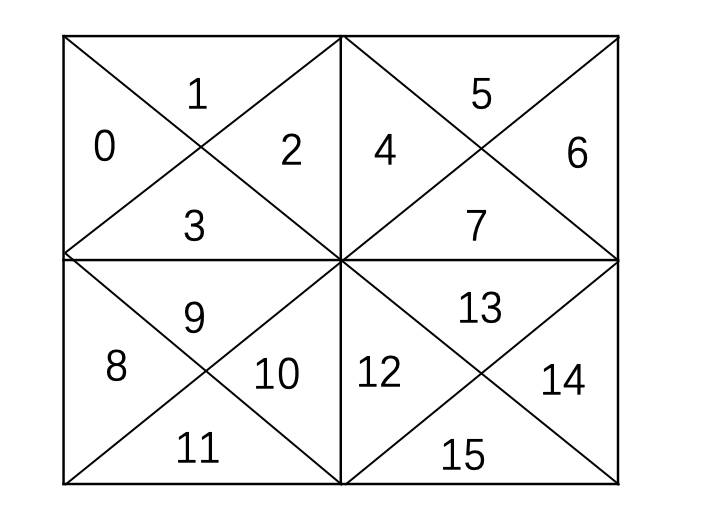题目描述
In a N x N grid composed of 1 x 1 squares, each 1 x 1 square consists of a /, \, or blank space. These characters divide the square into contiguous regions.
(Note that backslash characters are escaped, so a \ is represented as "\\".)
Return the number of regions.
Example 1:
Input:
[
" /",
"/ "
]
Output: 2
Explanation: The 2x2 grid is as follows:

Note:
1 <= grid.length == grid[0].length <= 30grid[i][j]is either'/','\', or' '.
题意:在由 1 x 1 方格组成的 N x N 网格 grid 中,每个 1 x 1 方块由 /、\ 或空格构成。这些字符会将方块划分为一些共边的区域。返回区域的数目。
算法1
(并查集)
题解:这题如果了解并查集的话还是很好做的。首先我们将每个方格按照对角线划分成四个区域,如下图所示,并且从按照顺时针方向为其编号。初始时每一个格子内部右边和右边格子内部左边是连通的,如(2,4),没个格子的内部下边和下边格子的内部上边是连通的(3,9)。接下来,我们读取每一个格子的字符:
/,那么把内部的左格子和上格子合并(0,1),右格子和下格子合并(2,3)。\,那么把内部的左格子和下格子合并(0,3),右格子和上格子合并(1,2)。,那么把内部四个格子合并。
最后统计一下所有的连通块个数。

C++ 代码
class Solution {
public:
vector<int> father,size;
int getfather(int x)
{
if(x != father[x]) father[x] = getfather(father[x]);
return father[x];
}
void uni(int x,int y)
{
int fatherA = getfather(x),fatherB = getfather(y);
if(fatherA == fatherB) return;
if(size[fatherA] < size[fatherB])
{
father[fatherA] = fatherB;
size[fatherB] += size[fatherA];
}
else
{
father[fatherB] = fatherA;
size[fatherA] += size[fatherB];
}
}
int regionsBySlashes(vector<string>& grid) {
int n = grid.size(),m = 4 * n * n;
father = vector<int>(m,0),size = vector<int>(m,1);
for(int i = 0 ; i < m; i ++) father[i] = i;
for(int i = 0 ;i < n ;i ++)
{
for(int j = 0 ;j < n ; j ++)
{
int k = i * n + j,t = (i + 1) * n + j,s = k + 1;
if(i != n - 1) uni(4 * k + 3,4 * t + 1);
if(j != n - 1) uni(4 * k + 2,4 * s);
}
}
for(int i = 0 ;i < n ; i ++)
{
for(int j = 0 ;j < n ; j ++)
{
int k = 4 * (i * n + j);
if(grid[i][j] == '/')
{
uni(k,k + 1);
uni(k + 2,k + 3);
}else if(grid[i][j] == ' ')
{
uni(k,k + 1);
uni(k + 2,k + 3);
uni(k + 1,k + 2);
}
else
{
uni(k,k + 3);
uni(k + 1,k + 2);
}
}
}
int res = 0;
for(int i = 0 ;i < m ;i ++)
if(i == getfather(i))
res ++;
return res;
}
};


👍 👍 👍
hxd, 能解释下siz数组在这里的作用吗?我用朴素find()也AC了
个人习惯吧,size数组代表当前联通块的数量,每次把数量较少的挂在数量较多的联通块上。可以搜一下并查集的按秩合并。